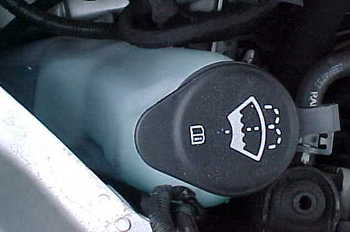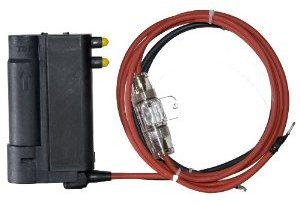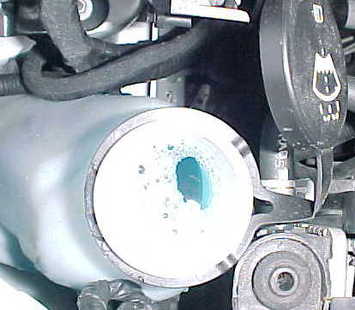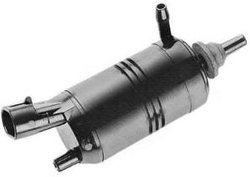Frozen Windshield Washers
 To follow will be some information on how to deal with frozen windshield washers. In a perfect world washer fluid would never freeze even on the coldest days in the coldest regions. This is why they have the blue colored windshield washer fluid that contains an anti-freeze to prevent this from happening. As a professional car mechanic I can tell you that even though your windshield washer fluid may look blue sitting in the bottle there could be a fair amount of water mixed in with it.
To follow will be some information on how to deal with frozen windshield washers. In a perfect world washer fluid would never freeze even on the coldest days in the coldest regions. This is why they have the blue colored windshield washer fluid that contains an anti-freeze to prevent this from happening. As a professional car mechanic I can tell you that even though your windshield washer fluid may look blue sitting in the bottle there could be a fair amount of water mixed in with it.
First of all many windshield washer fluids only protect to a few degrees below freezing. Often this is the $.99 cheap stuff that you might find at your local big-box retailer. Heavy duty fluids can cost a few dollars more but if you live in a cold environment this could be money well spent. When you take your vehicle in for an oil change and the shop is responsible for topping off the fluids all too often they stretch the cheap and weak windshield washer anti freeze by adding water to it. It still looks blue but doesn’t have the protection from freezing like when it was full strength.
We all want washer fluid too squirt out when we hit the button. Sometimes this is really important so that we can see out. Another bad side effect from the fluid freezing up is damage to the windshield washer system. When water freezes it expands a lot. Most of the system that distributes the water across a windshield is made of plastic and rubber. These items can be damaged when the water freezes and expands.
Fixing Frozen Windshield Washers
 The first thing we do is to get rid of the old fluid and install fresh stuff at full strength. There are several ways of accomplishing this. You can even go nuts and install a fluid heater (available below) a must for Alaska residents. Here’s how I do it. I have a hot air blower that I can plug-in and focus on the windshield washer bottle and hoses. The hot air circulates around the frozen fluid and eventually it will be defrosted.
The first thing we do is to get rid of the old fluid and install fresh stuff at full strength. There are several ways of accomplishing this. You can even go nuts and install a fluid heater (available below) a must for Alaska residents. Here’s how I do it. I have a hot air blower that I can plug-in and focus on the windshield washer bottle and hoses. The hot air circulates around the frozen fluid and eventually it will be defrosted.
There are other ways to thaw out this fluid such as using a heating pad that you stuff in and around the reservoir bottle. Heat rises so the lower you can get the warmth the better you are because it will radiate upwards. Once the fluid is completely defrosted you should be able to operate the washers and get the warmer fluid up into the lines eventually this will clear the ice. You want to operate the washers for only a few seconds or a minute. Running the pump against the frozen ice for several minutes could actually damage the pump itself. Give it a few seconds to rest in between activating the system.
 An even better way to handle this situation is to remove the reservoir bottle from the vehicle and take it inside the house and put it near a heater vent. You can place it in a bucket or pan so you don’t get water all over the house. The problem with this is some vehicles make it really hard to remove the reservoir.
An even better way to handle this situation is to remove the reservoir bottle from the vehicle and take it inside the house and put it near a heater vent. You can place it in a bucket or pan so you don’t get water all over the house. The problem with this is some vehicles make it really hard to remove the reservoir.
Some cars and trucks it’s a simple matter of removing a couple of 10 mm bolts and it comes right out, so this will depend on your make and model. If you’re able to remove the bottle you can also flush it in hot water and this will only take a few minutes to completely melt all the ice.
If the bottle is easy to install and remove you can fill the bottle with piping hot water and use this to flush the ice out of the lines and nozzles. You can then remove the bottle again completely drain it and fill it with full strength windshield washer anti freeze. In the end the trick is to first melt the frozen fluid and then get rid of all of it to be replaced with the real stuff at full strength.
Testing the Washer or System
Many windshield washer problems were caused by restrictions in the fluid lines or nozzles. This can be caused by ice that we have been discussing throughout this article but it can also be caused by debris and dirt that finds its way into the washer bottle. To check for restrictions you can remove the hoses from the pump and operate the system. If the pump ejects a stream of washer fluid than the fault is further forward in the delivery system.
You can reconnect the lines to the pump and disconnect the rubber hoses at the next juncture. When you get to a location where the fluid does not come out the problem is before where the hose was disconnected. I have seen mechanics use compressed air to diagnose the system and it really doesn’t work well because shop air can be at 90 PSI whereas the wash system is designed to run on low pressures such as 3 to 10 PSI. Not only can you damage the hoses with compressed air but they will usually blow off at the plastic connections and this won’t help find the clog.
 The only thing we haven’t covered yet is the windshield washer pump itself. If you disconnect the rubber lines from the pump and you operate the switch and you hear it run yet not fluid comes out the pump could be bad. It might also be clogged. You can remove the pump from the fluid reservoir or wherever it’s located to perform a closer inspection. If you hear it run and no fluid comes out at least you know that the electrical part of the system is functioning properly as in you have a good power and ground. The washer pumps themselves are not expensive and you may elect to replace it and retest.
The only thing we haven’t covered yet is the windshield washer pump itself. If you disconnect the rubber lines from the pump and you operate the switch and you hear it run yet not fluid comes out the pump could be bad. It might also be clogged. You can remove the pump from the fluid reservoir or wherever it’s located to perform a closer inspection. If you hear it run and no fluid comes out at least you know that the electrical part of the system is functioning properly as in you have a good power and ground. The washer pumps themselves are not expensive and you may elect to replace it and retest.
I hope you found this article helpful and that you take a minute to share it with your friends or family that might also have a problem with frozen windshield washers. There is nothing worse than driving down the highway after a snowstorm and having that gray mixture of muddy water, snow, salt, and whatever else your County throws on the roadways kicked up onto your windshield and not being able to wash it clean so you can see. I’m working on another article about other problems in this system. You can head back to the auto repair blog homepage to see if it’s up yet.

